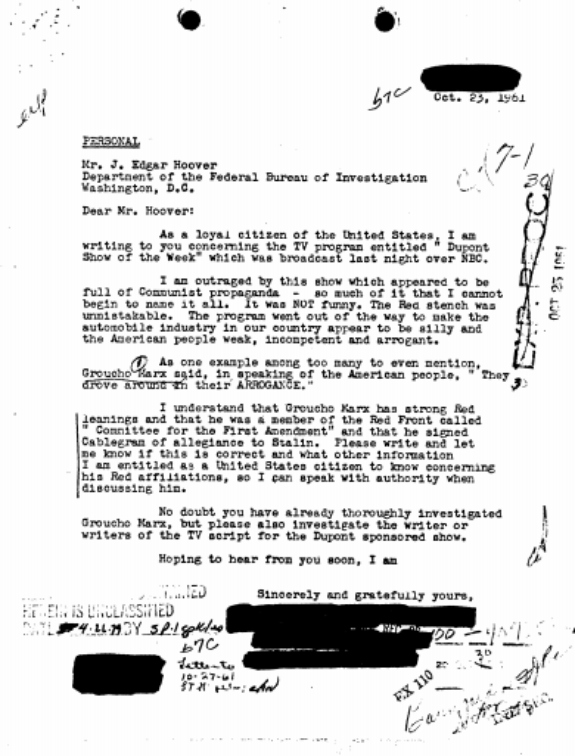In 1953, the FBI was told by one of its confidential informants that Groucho Marx "contribute[d] heavily to the Communist Party". The Bureau subsequently started to investigate the comedian and during the next decade built a file on him containing numerous pages. The file included evidence of Groucho's pro-communist sympathies, e.g. a 1934 article in the Communist Party newspaper the Daily Worker, saying Groucho had called the communist support for the Scottsboro Boys an inspiration for "Soviet America"; Groucho's attendance at a benefit concert for Soviet war relief in the 1940s; his opposition of Franco's fascist, anti-communist government of Spain; and his membership of the Committee for the First Amendment, which protested the investigations into communism in Hollywood conducted by the HUAC (House Un-American Activities Committee).
Despite the sizeable file, the FBI ultimately concluded that Groucho was not a member of the Communist Party. The HUAC reached the same conclusion and never even called Groucho to testify. They did, however, summon Jerry Fielding (Groucho's bandleader on the popular tv show You Bet Your Life) to testify in December 1953. Fielding later said that HUAC probably wanted him to name Groucho, but he had refused to name names and was consequently blacklisted. Pressured by his sponsors, Groucho eventually fired Fielding — a decision he would later call "one of the greatest regrets of [his] life".
Among the many documents that can be found in Groucho's FBI file are the following two letters, written by concerned US citizens to FBI director J. Edgar Hoover regarding Groucho's communist leanings. By the time the letters were written, on resp. 17 June 1960 and 23 October 1961, the FBI had already been investigating Groucho for years.
Transcript:
Mr. J. Edgar Hoover
Federal Bureau of Investigation
Washington, D.C.
Dear Mr. Hoover:
I suggest that the TV entertainer Groucho Marks [sic] be investigated as being a Communist.
Last night on his program both my husband and I understood him to pronounce "The United States" as "The United Snakes".
In his book "Groucho and Me" he speaks quite affectionately of Charlie Chaplin, who is a well known Communist.
By the way, your own book "Masters of Deceit" is a masterpiece. I have bought a copy for myself and four or five copies as gifts. It is simply a wonderful book. Thank you for it.
Please, Mr. Hoover, investigate Groucho Marks [sic].
Sincerely,
[redacted]
Transcript:
Oct. 23, 1961
PERSONAL
Mr. J. Edgar Hoover
Department of the Federal Bureau of Investigation
Washington, D.C.
Dear Mr. Hoover:
As a loyal citizen of the United States, I am writing to you concerning the TV program entitled "Dupont Show of the Week" which was broadcast last night over NBC.
I am outraged by this show which appeared to be full of Communist propaganda - so much of it that I cannot begin to name it all. It was NOT funny. The Red stench was unmistakable. The program went out of the way to make the automobile industry in our country appear to be silly and the American people weak, incompetent and arrogant.
As one example among too many to even mention, Groucho Marx said, in speaking of the American people, "They drove around in their ARROGANCE."
I understand that Groucho Marx has strong Red leanings and that he was a member of the Red Front called "Committee for the First Amendment" and that he signed Cablegram of allegiance to Stalin. Please write and let me know if this is correct and what other information I am entitled as a United States citizen to know concerning his Red affiliations, so I can speak with authority when discussing him.
No doubt you have already thoroughly investigated Groucho Marx, but please also investigate the writer or writers of the TV script for the Dupont sponsored show.
Hoping to hear from you soon, I am
Sincerely and gratefully yours,
[redacted]





















































